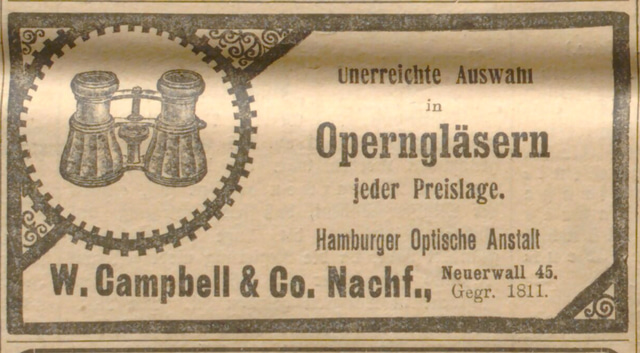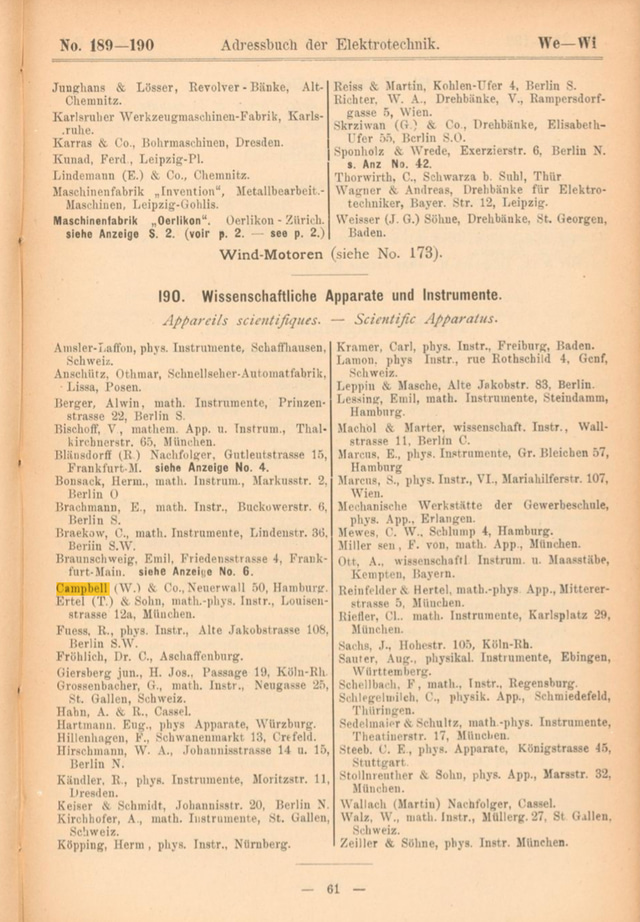

The optical firm W. Campbell & Co. was founded in Hamburg in 1816 by the Scottish craftsman William Campbell. He opened one of the city’s first specialized optical shops, which over time became known as the Hamburger Optische Anstalt (“Hamburg Optical Establishment”). By the 1840s, Campbell’s enterprise had earned a solid reputation in the trade of spectacles, telescopes, and scientific instruments. After roughly three decades of successful work, the founder retired, and the business passed to his successors. Historical evidence from 1843 mentions a photographic studio run by H. Biow, located “above the optical shop of the successors of Campbell.” This indicates that by that time, the company was already managed by new owners who had retained the Campbell name as a well-established brand.
In the 19th century, the company continued to operate under the name “W. Campbell & Co. Nachfolger” (i.e. “Successor to W. Campbell & Co.”). The addition of “Nachf.” signified that the new proprietor had formally inherited Campbell’s business and continued trading under the original name. One of the earliest known successors was the entrepreneur J. Wm. Wohlers — at the 1873 Vienna World Exhibition, the firm exhibited as “W. Campbell & Co. Nachfolger, Inhaber: J. Wm. Wohlers, Hamburg,” presenting a “universal weather glass” of its own manufacture. Thus, by the 1870s, the Wohlers family had taken over the enterprise, expanding its product range.
By the late 19th century, W. Campbell & Co. Nachf. had grown into a large company offering a wide variety of optical and scientific instruments. In Hamburg address directories at the turn of the century, it is listed as a supplier of wissenschaftl. Apparate (“scientific apparatus”) with a store at Neuer Wall 50. Its range included:
Meteorological instruments: barometers (aneroid and mercury), storm glasses, and thermometers. The company became well known for its weather instruments. Optics and photography: as one of Hamburg’s oldest optical houses, Campbell & Co. sold spectacles, magnifiers, as well as cameras and projection devices. In early 20th-century advertisements, the firm called itself a “Diplom-Optiker”, emphasizing its professional qualifications in optics. It is known to have offered the then-advanced Zeiss Punktal spectacle lenses (developed by Carl Zeiss). Surviving pre-war advertising postcards show Campbell acting as a Hamburg representative of Carl Zeiss. Naval and surveying instruments: Hamburg’s port status created strong demand for navigation equipment. Catalogues mention marine sextants, binoculars, and spyglasses marked Campbell. For instance, in the early 20th century, Carl Schütz (Cassel) binoculars were sold through the Campbell shop in Hamburg, as shown by the engraving “Niederlage W. Campbell & Co. Nachf., Hamburg” on one eyepiece (the word “Niederlage” meant a local branch or agency of a manufacturer). The firm also sold opera glasses, microscopes, and other optical goods for a broad clientele. Its Neuer Wall store was renowned for its abundance: the newspaper Hamburger Fremdenblatt in 1909 advertised “the richest selection of opera, field, travel and marine binoculars and telescopes, famed for their optical quality.” Thanks to its high standards and direct connections with leading manufacturers (both German and foreign), Campbell & Co. Nachf. gained European renown. Historians later described it as “the largest optical atelier, well known throughout Europe,” and its name in Hamburg became synonymous with high-class goods.
The firm’s main salon had been located since the 19th century on the prestigious Neuer Wall in central Hamburg, near Jungfernstieg. The building number changed over time: in the 1840s it was No. 24 (later renumbered to 52); by the early 20th century, the shop was at Neuer Wall 50; around 1909 — at Neuer Wall 45; and in the 1934 telephone directory it appears as “W. Campbell & Co. Nachfl., Neuer Wall 30.” These relocations were likely due to expansion or reconstruction in the fast-growing commercial district. In any case, the firm remained continuously on Neuer Wall for over a century, making it one of the street’s oldest surviving businesses.
The company leadership also passed through several generations. After J. Wm. Wohlers, the business was inherited by his son or relative Hugo Wohlers, who appears in turn-of-the-century advertisements as “Inhaber: Hugo Wohlers.” Under his management, the company entered the 20th century, retaining the name “W. Campbell & Co. Nachf.” and its prestigious clientele. Later, however, ownership changed again: according to research on Jewish entrepreneurs in Hamburg, around 1906 the firm was purchased by a new owner of Jewish descent. His name does not appear in surviving public records (possibly due to the transaction being anonymized), but by the 1930s the Nazi authorities classified Campbell & Co. as a “Jewish enterprise.” Nevertheless, the storefront sign with the Campbell name remained, and the shop continued to operate until the late 1930s.
With the rise of National Socialism, the company shared the tragic fate of many of Hamburg’s long-established Jewish-owned firms. After the Kristallnacht pogrom (November 1938), the owners of Campbell & Co. were arrested by the Gestapo, and the business was forcibly seized. Tax-office (Finanzamt) documents show that on 17 November 1938, a temporary Treuhänder (Nazi “trustee administrator”) named Hermann Schönberg was appointed to manage W. Campbell & Co. Nachf., Neuer Wall 30. In December 1938, a full “Aryanization” followed: the Jewish owners were stripped of their rights, and the company’s assets were sold or transferred to “Aryan” competitors for a pittance. Archival records indicate that by early 1939 the shop at Neuer Wall 30 no longer belonged to its previous proprietors. The Campbell name may have continued in limited use but was no longer associated with a particular family — it survived only as a brand that had outlived the war.
The story took an unexpected turn after 1945. In the post-war years, the old Hamburg optical shop was revived by a German entrepreneur (unrelated to the former owners) — the Paulik family. They preserved the legendary name: by 1946, a store reopened at Neuer Wall under the sign “Campbell – Optiker seit 1816.” The new proprietor presented himself as the inheritor of Campbell’s tradition, though legally the firm was newly founded. Carefully rebuilding its pre-war reputation, the Paulik family succeeded in restoring the shop’s status as one of Hamburg’s finest optical salons.
As of 2025, Campbell Optik (full name “Campbell, Optiker seit 1816 GmbH & Co. KG”) is run by the third generation of the Paulik family, continuing the brand’s unbroken legacy. Remarkably, it remains the oldest store on Neuer Wall, and perhaps the only pre-war business on the street still in operation. Thus, the name W. Campbell & Co. has endured for over two centuries — through dynastic changes, war, and rebirth in the modern era.
Sources and References: